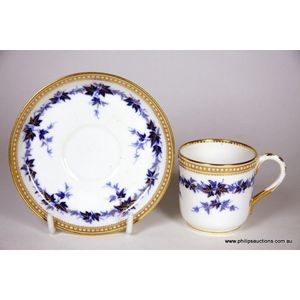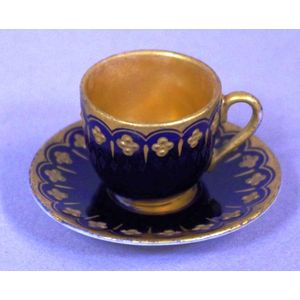Carlton Ware Egyptian Fan Coffee Service
You must be a subscriber, and be logged in to view price and dealer details.
Subscribe Now to view actual auction price for this item
When you subscribe, you have the option of setting the currency in which to display prices to $Au, $US, $NZ or Stg.
- Coffee Can - A coffee can is a cup for holding coffee, but of a cylindrical shape rather than the waisted shape of traditional cups. They were in use at the end of the 18th century and in the early 19th century.
- Jewelled Decoration - Jewelled decoration on ceramics is a technique where small, colourful, and often metallic beads or "jewels" are applied to the surface of ceramic objects to create intricate and highly decorative designs. This technique has been used throughout history and across different cultures, but it was particularly popular during the late 19th and early 20th centuries, especially in Europe.
The jewelled decoration is usually applied by hand, one bead at a time, onto a base glaze or enamel. The beads can be made of glass, porcelain, or even precious stones, and are often set in a metal setting, such as gold or silver. The end result is a highly decorative and often luxurious surface, which can add a lot of visual interest and value to the ceramic object.
Jewelled decoration was used on a wide range of ceramic objects, including vases, plates, bowls, and figurines. It was particularly popular in the Art Nouveau and Art Deco periods, where it was used to create highly stylized and ornate designs. - Gilding - Gilding is a method of ornamentation whereby a thin sheet of gold metal is applied to items made of wood, leather, ceramics, glass and silver for decorative purposes.
For furniture including mirrors, the sheet of gold is usually applied over a coating of gesso. Gesso is a mixture of plaster of Paris and gypsum mixed with water and then applied to the carved wooden frames of mirrors and picture frames as a base for applying the gold leaf. After numerous coats of gesso have been applied, allowed to dry and then sanded a coat of "bole", a usually red coloured mixture of clay and glue is brushed on and allowed to dry, after which the gold leaf is applied. Over time parts of the gilding will rub off so the base colour can be seen. In water gilding, this was generally a blue colour, while in oil gilding, the under layer was often yellow. In Victorian times, gilders frequently used red as a pigment beneath the gold leaf.
Metal was often gilded by a process known as fire gilding. Gold mixed with mercury was applied and heated, causing the mercury to evaporate, the long-term effect of which was to kill or disable the craftsman or woman from mercury poisoning. The pursuit of beauty has claimed many victims, not the least of which were the artists who made those pieces so highly sought after today. - Attributed - A cataloguing term where the item in the opinion of the cataloguers, is a of the period of the artist, craftsman or designer, and which probably in whole or part is the work of that person.
This item has been included into following indexes:
- Carlton Ware (England), item types
- Carlton Ware (England), patterns
- Elmer, Violet, England - Carlton Ware (England), designers 24
Visually similar items

A Royal Worcester demitasse cup and saucer, 1878, pattern B 379, with trailing borders of dark and light blue ivy and gilded highlights with jewelled borders upon a white ground; with puce backstamp, pattern number and decorator's mark underside. Height 5.

A decorated cup and saucer in the manner of Paris Porcelain, 19th century. The Empire footed cup with a waisted neck, flared rim and a scrolling handle, with a painted scene of figures and buildings beside a lake within a scale decorated gilded border, wit

A Samson of Paris cup and saucer, circa 1890, marked underside with a 'Curvaceous X' to indicate English-style Ware, both straight sided cup and saucer with grisaille decoration of a European lakeside landscape with figures, boats and castles upon a lemon

Miniature Coalport cobalt blue & gilt cup & saucer
